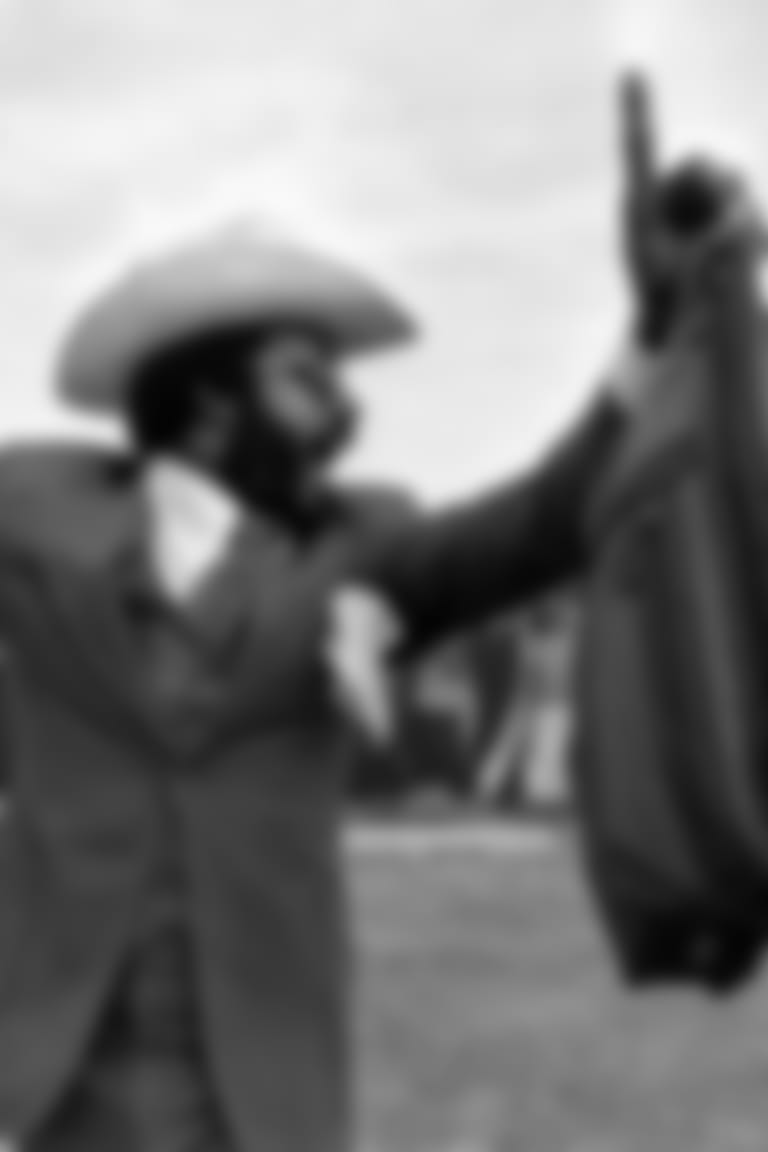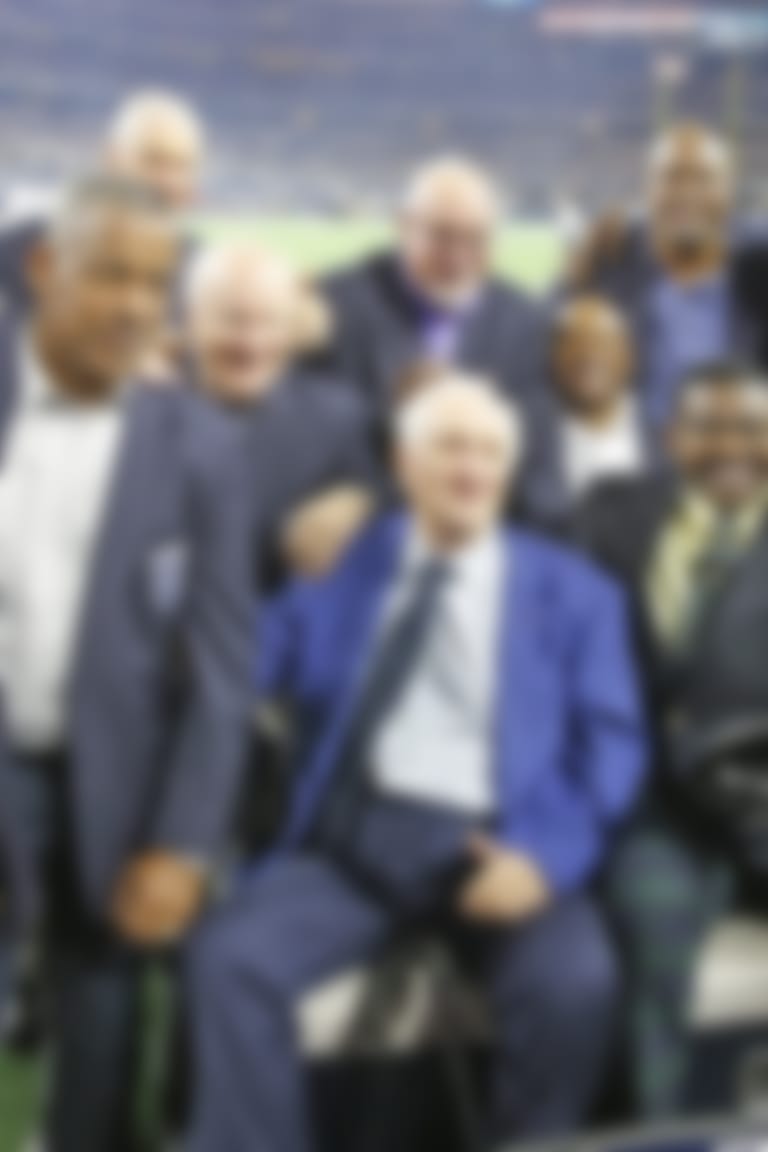Gil Brandt gets enshrined in Canton this week, but the players he discovered in three decades with the Cowboys, including one who wrote him letters from prison, have long considered him a Hall of Fame friend
By Andy Fenelon | Published July 29, 2019
Laying on his cot inside the maximum-security prison near the California-Oregon border, just eight days into a 56-month prison term and 244 days into sobriety, Thomas Henderson began writing the toughest letter of his life to the man partly responsible for him not securing a potentially lighter sentence.
Henderson was writing a lot of letters from his Susanville Correctional Facility cell in the latter part of 1984 -- to former Dallas Cowboys teammates, coaches, and friends. It was part of Step 9 in the 12-step program he was undergoing for alcohol and substance abuse: Make direct amends to people you have harmed wherever possible.
But this letter, written on July 9, 1984 -- the first of three he would pen to Gil Brandt, the former Cowboys executive who will be enshrined into the Pro Football Hall of Fame on Saturday -- was particularly agonizing. A few months earlier, while Henderson was awaiting sentencing for the sexual assault of an underage girl, among other serious charges, Brandt had provided a non-glowing statement to a probation officer that would help determine the fate of the player he had scouted, drafted and signed a decade earlier.
The statement brought to light an incident that involved Henderson asking Brandt for money to support his $10,000 a week cocaine habit. Brandt didn't believe much leniency should be granted by the sentencing judge, that the Pro Bowl linebacker -- formerly known as "Hollywood" for his flamboyant and outspoken nature during his playing days with the Cowboys -- needed significant time in prison to fully appreciate the consequences of his actions.
Henderson's conundrum: Should he express forgiveness or blame?
He chose love and hope.
Hi Gil,
I was shocked at the probation report when I saw the statement you gave. I guess I brought it on myself.
I remember that conversation a little. During that time, I was very desperate for money to buy more drugs. It's a damn shame I would do something stupid like that. Bite the hand that could possibly help me. I want to apologize for that behavior. It's not anyone's fault but mine (as) to what happened to me.
I can tell you (from) one man to another that I became a real dope addict. But I must always take responsibility for what has happened to me. It's not the Cowboys' fault or any team member's fault -- just mine.
As good as you were to me, I forced you with bribery and other things to make you work against me. Gil, I'm truly sorry for my past behavior, and know that I'm taking all responsibility for my downfall.
I had forgotten about that incident but remembered it right away when I was sitting in prison and a probation officer told me what you said about me. See, Gil, if I hadn't put you in that position when I did, I'm confident that you would have had nothing but praise for me.
I've been clean and sober now for eight months. Although I'm still in prison, I will be clean and sober for one year on Nov. 8th.
In the next couple of years here I'm going back to school and I want to become an alcohol and drug therapist. Please don't give up on me, Gil. I've still got a chance to be a productive person again.
Tell Too Tall and Harvey (Martin) if you talk to them that my younger brother named Allen -- you met him also -- committed suicide on June 23rd; he hung himself. He had been freebasing cocaine and, what can I say?
If ever I can talk to a guy, write someone or anything, Gil, don't hesitate. I'll do it for you because I owe you. If you will, give my regards to all.
Your friend still -- Thomas Henderson
P.S. Please forgive me for my past actions. Give me a chance on my future actions. -- T.H.
"I had clearly disappointed him. I had disappointed myself. I had disappointed so many people with the Cowboys," Henderson said recently from his home in Boca Raton, Florida. "The Cowboys had always been good to me and I screwed that up. That's why I apologized to Gil in those letters. I knew that I was one of his diamonds in the rough; I was one of his finds."
Henderson is one of the many "finds" Brandt had in his nearly 30 years with the Cowboys. In many ways, he epitomizes Brandt's greatness -- perhaps better than most players Brandt brought through Dallas when he was the Cowboys' vice president of player personnel from 1960 to 1989.
On Saturday, at his Hall of Fame enshrinement in Canton, you're likely to hear stories about what made Brandt stand out among his NFL peers, including the scouting and evaluation system he developed and installed with the Cowboys that led to 20 consecutive winning seasons, two Super Bowl victories and the drafting of nine Hall of Fame players; the introduction of computers to scouting to help find hidden talent; the use of psychological tests to evaluate mental makeup under pressure; the discovery of athletes from previously untapped sources, including small schools and black colleges, and even from other sports.
But the special relationships he shared and continues to foster with his players, including the bond he's formed and maintained with Henderson over the last 46 years, are Hall of Fame-worthy in their own right.
A few weeks ago, Brandt was checking messages on his answering machine when he came across a voicemail from a man he had drafted more than 50 years ago. The accomplished offensive lineman had called to belatedly congratulate his former boss on his Hall of Fame selection.
After a few words, there was a pause. The man, now in his mid-70s, continued.
"I'm just very, very grateful to have had you in my life at a time when I really needed you, and you helped me tremendously," he said, his voice cracking. "So, I wanted you to know I care …"
Through tears, the man hurriedly said goodbye and hung up the phone.
Ask Brandt about the impact he made in the front office of the Cowboys, and he'll talk your ear off, regaling you with stories from yesteryear, half of which sound beyond belief. Like the time he held up the 1964 NFL Draft for six hours waiting on medical reports for a player who was so distraught over the assassination of John F. Kennedy that he punched a mirror, cutting his wrist badly. Or the time, as a 26-year-old, he signed his very first player, out-bidding Chargers GM Frank Leahy, who had drafted the kid -- Dartmouth halfback Jake Crouthamel -- in the first round of the AFL draft.
But ask Brandt about the impact he's made in the lives of the players he discovered, signed and befriended along the way, and he is suddenly at a loss for words. This 86-year-old extrovert is clearly not comfortable talking about his feelings.
Others, however, are more forthcoming, if not in words then by their actions.
He still draws a crowd at events where his former players are gathered. At his Ring of Honor induction last November, Drew Pearson escorted Brandt everywhere he went in AT&T Stadium, treating him with the gentleness he received from Brandt as a player. And there was Mel Renfro (the player who had injured his wrist after the JFK assassination), placing a kiss on the side of Brandt's head shortly after Brandt had delivered his speech at halftime of the Cowboys-Saints game, formally joining a group that includes 15 of the players he personally acquired for the Cowboys.
There is an unmatched executive-player reverence, a genuine love and affection for a man who has meant so much to so many for so long.
The first time Brandt saw Thomas Henderson, he was scouting Clint Longley, a Small College All-American quarterback from Abilene Christian the Cowboys would eventually trade for in 1974 (and whom Brandt would trade two years later after Longley infamously sucker-punched his teammate, and everybody's All-American, Roger Staubach). Abilene was playing a playoff game against Langston in Henderson's junior year at the all-black NAIA Oklahoma university.
Despite its enrollment of just 1,100 students, Langston entered the game undefeated, thanks in large part to Henderson, who, in Coach Big Daddy Nivens' Sic 'Em defense, was destroying opposing quarterbacks (sack statistics weren't around then, but some estimate Henderson accounted for more than 40 on the season). Langston lost the game, but not before Brandt took notice of Henderson's dominant day; he was named the game's defensive MVP.
A decade earlier, Brandt had hired Dick Mansperger as a scout. One of Mansperger's main responsibilities was to provide the Cowboys lists of draft-worthy players from black colleges, along with their height, weight, 40-yard times and a rating. This quantitative data was placed into the Cowboys' computer system and out spit names of players many had never heard of, or from schools – particularly the black colleges – most NFL teams didn't bother sending their scouts to.
In a time when many teams were still drafting players out of Street & Smith's magazine, it was a system that helped Brandt discover and procure small-school stars like Bob Hayes (Florida A&M), Jethro Pugh (Elizabeth City State), Rayfield Wright (Fort Valley State), Cliff Harris (Ouachita Baptist), Harvey Martin (East Texas State), and Ed "Too Tall" Jones (Tennessee State).
So, by the time Henderson entered his senior year at Langston, the Cowboys' scouting system was well-established and dominating the NFL competition, turning the expansion franchise Brandt joined in 1960 into a dynasty that became known as America's Team.
"Gil was brilliant at finding people," Henderson said.
To drive his point home, Henderson begins to tell the story of how Brandt supposedly found Pugh, a fictitious yarn that "Bullet" Hayes often told in the locker room, and one that was repeated by Wright at Pugh's funeral in 2015.
As legend has it, Brandt was headed in his car down a rural road in North Carolina in the early '60s, attempting to uncover the next great hidden gem for coach Tom Landry to develop. When he came upon a young man plowing a field, Brandt stopped and asked for directions to the house of a player he had traveled more than a thousand miles to meet. Without saying a word, the young man lifted the plow and used it as a pointer. Brandt's eyes widened.
"Forget about him," Brandt said excitedly. "What's your name?"
The Cowboys took Pugh in the 11th round out of tiny Elizabeth City State in 1965. Henderson's wait – exactly 10 years later – lasted only 18 picks into a draft that saw Brandt select an unprecedented 12 players who would make the final roster that year and fast-track the Cowboys' rebuilding project. And while Dallas had enjoyed a lot of success with small-school players by that time, including the selection of "Too Tall" a year earlier, not everyone was completely on board with Henderson.
"A couple of years ago, I asked Gil, 'When you were in the draft room there with Landry and he wants to take someone from Penn State or Notre Dame or Michigan or UCLA, how the hell did you get him to pick me in the first round?' " Henderson said. "And Gil replied, 'I was pounding on the table, saying this is the best player on the board, we should have picked him earlier.' "
Brandt confirmed the story. He and scout Red Hickey were the only two from the Cowboys who had personally seen Henderson play. Back then, game film wasn't readily available, and for small schools like Langston, it was virtually impossible to acquire. But the Cowboys had scouting systems in place they trusted, and even though Henderson might have still been available in the third round, Dallas took its shot in the first, much to the surprise of other front offices around the league.
When Henderson showed up at the Cowboys' headquarters the next day, he met Brandt in person for the first time. In his autobiography, "Out of Control," Henderson described that meeting and his first impression:
"Most of what I noticed about Gil Brandt was the way he assaulted his chewing gum. I'd never seen anything like it. The guy was pretty speedy. He had no chin and his mouth was yapping and he just loved to attack that gum."
After some small talk, Brandt got down to business.
"Abner Haynes is your agent, that right? Abner and I are good friends. I'll be in touch and we can get together and get your contract straightened out. You don't think we'll have any problems signing it, do you?"
"I knew a hustle when I heard one, this was just like pool. I told him, 'I don't know, man. I just know that the No. 1 draft choice gets a lot of money, doesn't he?' "
Later in his book, Henderson describes a visit he made to Brandt's office, telling the team negotiator he had outgrown his second contract and wanted a new deal commensurate with what Steelers All-Pro linebacker Jack Lambert was making. Brandt told Henderson that he was making more than most linebackers in the league, then offered him Lambert's contract.
"You really want that contract? I'll draw it up. You really want that contract?"
Without the aid of an agent or the public knowledge of player salaries that exist today, Henderson declined. He said he later found out what Lambert was making and should have called Brandt's bluff.
"He faked me out. Gil Brandt is a damn good general manager … if you call screwing people (doing) a good job."
On a yearly basis, Everson Walls thought he was being screwed. The cornerback Brandt signed as an undrafted free agent out of Grambling State in 1981 outplayed his contract annually, and each time he did he asked for it to be re-done. Seven times in all. The denied requests often led to public threats of walkouts and retirements and were accompanied by team fines handed out by Brandt.
It got so contentious that Walls considered the unthinkable.
"Someone once asked Everson how it was to negotiate with me," Brandt recalled. "He said, 'If I could have found one, I would have hired a hitman to take Gil out.' "
As with most things, time tends to heal bruised egos. Today, Walls and Brandt are more than cordial; they're friends who have openly campaigned for each other's Hall of Fame bids. Henderson also understands there was nothing personal between him and Brandt in their contract negotiations.
"Gil was the negotiator so our relationship, in terms of business, was tumultuous," Henderson said. "He was the guy who when you asked for 90 thousand (dollars) he wanted to give you 40 (thousand). But Gil Brandt was very good at what he did."














